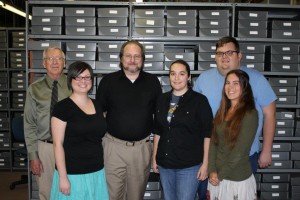by Kelly Kraemer
Participating in TLAM and the Convening Culture Keepers over the last two years has allowed me to practice what I love as a librarian in a way that serves a community that, as a member of the Oneida Nation of Wisconsin, had given me so much. In the process, I’ve had the opportunity to learn about the different ways that American Indian communities and tribes are working to preserve and share their history and culture through different library, archive, and museum initiatives in Wisconsin. It’s an experience that has taught me a lot about the value of efforts to preserve tribal culture, history, and art as a way to tell our own stories and as a means of restoring and enriching our communities. This summer I had another opportunity to see what others in tribal libraries, archives, and museums community are doing outside of Wisconsin.

Every year the Sequoyah National Research Center (SNRC) in Little Rock, AR, offers summer internships for tribally affiliated students who have an interest in archival work. For this summer, two others and I are joining Dr. Daniel Littlefield and the staff of the SNRC to work on projects to process and catalog parts of the collection. I joined two others, Daniel Pewewerdy (Comanche) and Kile Byington (Choctaw), in working on several different cataloging projects. It’s been great getting to know my co-interns over the past few months. In addition, I’ve enjoyed spending time with the SNRC staff, especially the Director, Dr. Littlefield, Archivist Erin Fehr (Yupik), and Special Projects Coordinator Tony Rose.
Our projects have touched on many different parts of the SNRC’s extensive collections, which Dr. Littlefield, along with his colleagues Drs. James Parins, Robert Sanderson, and J.W. Wiggins have developed over the past thirty years. With the mission of preserving the words and ideas of American Indians by collecting writings, newspapers, art, and historical documents from around the nation. The large research archive is also the home for the records and personal papers of numerous indigenous writers, artists, and organizations. Some of the major highlights of the center are the American Native Press Archive and Native American Art Collection – my personal favorite is that they also keep the official records for the American Indian Library Association (AILA).
The work we’re doing this summer is in part contributing to a larger ongoing project at the center to update its catalog holdings and finding aids. This includes acquiring a brand new online cataloging system that, once it goes live, will allow the SNRC to share the invaluable resources of its archive, library, and art collection with a much wider audience. While collecting and preserving indigenous art and writing is an extremely important component for the center – and the development of an extensive network tribes, communities, and individuals that can contribute to it – it is equally as important to ensure that those same communities have access to those materials. This two-fold challenge of both preservation and accessibility is something that has been a common theme in TLAM and Culture Keepers. I’ve been able to see that the staff here really understand these challenges and take the task of addressing them seriously, with the result being an incredible repository of indigenous history that continues to grow. Over the summer, the center has stayed busy with a steady stream of visitors to the art gallery and researchers who have utilized the collection for their own work. Besides the new catalog and continued collection development, long-term goals for the SNRC include plans for moving into a new facility – construction for it is set to start in 2014.
You can follow the Sequoyah National Research Center on Facebook and Twitter.
